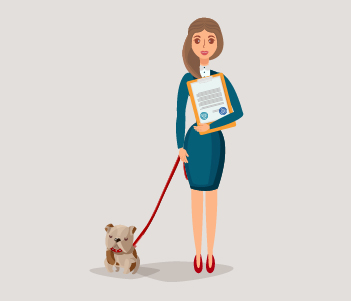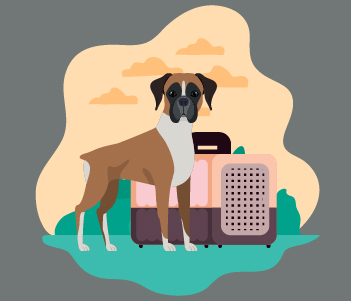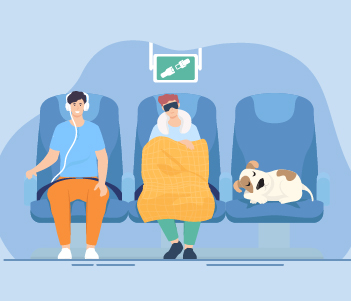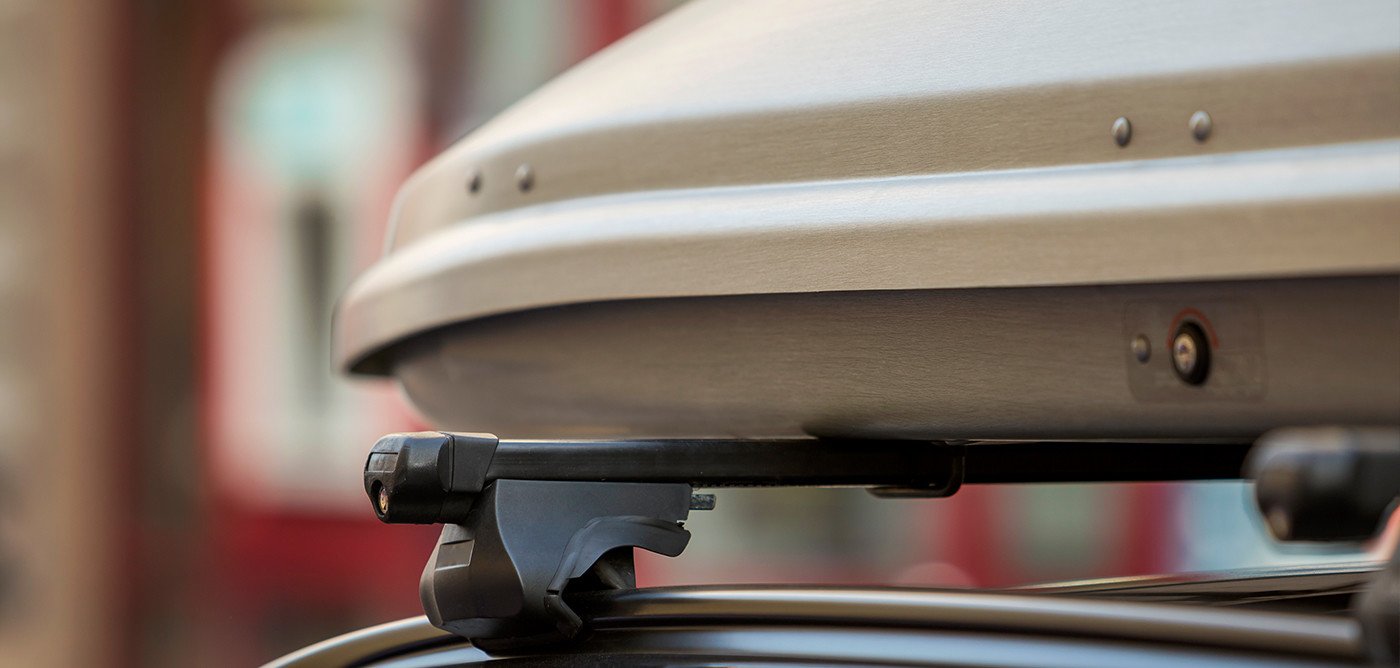Table of Contents
Introduction

Traveling is a breathtaking, eye-opening experience. Getting the chance to see new places and experience new cultures is essential in life. But there’s something else that’s arguably more important – our pets.
You’ve probably heard people telling you before that it’s not possible to travel with your furkids. We’re here to tell you that travel is indeed possible with your furry friends along for the ride. You just need to make a couple of extra simple provisions.
So, how exactly do you travel with a dog, and what do you need to know? Read on to find out.
Planning Your Travels With A Dog

The first step to having a successful trip, whether you’re with pets or not, is planning. Fail to prepare, prepare to fail they say, and that’s true in this case. There are a few things that you need to plan in advance before you embark on that dream trip with your fur baby.
Consider Visiting A Pet-Friendly Route/Destination
While you can travel with your pet, there are still some limitations.
Some places won’t allow dogs – such as certain hotels and locations like museums. This is easily solved by looking for pet friendly places.
For instance, you could take your pet with you to a national park, or on a hiking trip up a mountain.

Even some cities are a good choice. Try to stay away from any locations with very high temperatures as this can sometimes put your dog’s health at risk if you don’t take precautions.
You should also consider the distance that you will be able to travel with your pet. Sure, maybe you can sit in the car for a few hours jamming to your tunes, but can your pet withstand it? Some dogs struggle with being in cars – it can make them anxious!
This isn’t true for every pet, but this anxiety may mean that leaving your pet in a car for too long isn’t the best move. Some dogs can also get a little case of home sickness, so it’s worth being mindful of that too.
Sticking to a routine can be helpful with this – such as feeding them at the same time as usual and giving them a set amount of time each day where they can run around to their heart’s content.
But what about when you get there? Yep – when you travel with a pet you also need to make extra considerations about your accommodation. It can be somewhat challenging to try to book a pet friendly at home.
Some places will not tolerate pets at all, whereas others will openly invite your precious furkids with open arms. Some may have rules.
Check your hotel’s policies right off the bat. Don’t book a hotel until you know that it’s pet friendly.
Make sure that you check if the hotel accepts certain weights and breeds, and if you have a few dogs then you also need to think about how many pets you can have in each room. You may also be charged extra fees for bringing your pet with you, so make sure that you budget for that.
In addition to this, consider what kind of add ons the hotel offers for your pets – some places may have a doggy day care, or a dog spa – perfect for your pampered pooch!
Some places also may not allow pets to be unattended, so keep this in mind. Be mindful not to bring your pet into places that they may not be allowed to visit too.
Checking In With The Vet

If you’re planning on going traveling with your pet then it’s absolutely essential that you get a check up with your vet before you go.
After all, you want to make sure that it’s safe for your dogs to travel with you. Like with humans, there are some health conditions that mean taking a dog on a plane could be dangerous.
There are a number of different reasons why it’s a good idea to visit your vet before you and your pets board the plane.
- Your vet will be able to microchip your dog, which means that if your pet somehow goes missing while you are away they can be found more easily. It allows them to be identified – so long as you follow the instructions and register your pet on the database.
- Your vet will be able to clarify that your pet is up to date on all of their vaccinations, such as for rabies. Some countries will require that this is done, and will ask for a vaccination certificate to prove it.
- The vet can confirm your pet’s general health before you go on your trip
- Any prescriptions that your dog has can be renewed so they are all ready to go when you’re ready to go on your trip
- A health certificate can be completed, something that can be mandatory before going to some countries.
When you go to the vet you can also talk about any health conditions that could put your pet at risk when you are traveling in a certain country.
For instance, they can give you advice on how to protect your pet from things like ticks and mosquitos, or foot blisters from floors that are excessively hot.
They can also advise you about any uncommon animals that could cause a threat to you or your dog in the country that you are visiting.
Before you book the vet appointment though it’s worth looking at the laws in the country that you are visiting. For instance, certain countries may require a clean bill of health before your pet can be admitted, or you may be required to muzzle your pet when you are traveling in public.
On that note, it’s hard to know what will happen so it’s always a good idea to have pet insurance in case your pet needs any help from a vet while you’re out of the country. Get your pet some pet insurance just for extra peace of mind.
Documents You Might Need
You will also need to acquire certain documents before you try to travel with your pet.
By far the most important document that you will need when traveling with your pet is a pet passport.
These are generally fairly affordable, and are pretty similar to a human passport – a photo will be taken of your pet, and the passport is there to confirm that your pet is safe and eligible to travel.

If you are getting a pet passport then you are going to need to do a few things, especially if you’re traveling to somewhere like the UK.
First of all, you will need to microchip your pet – a pretty important thing to do anywhere. The dog will also need a rabies jab, and will need tapeworm treatment.
Make sure that your pet’s vaccinationsyour pets vaccinations are up to date, and take a photograph of your pet for their passport.
Go on – we know you already have plenty of photos of your dog so this step should be simple enough! You may also need other things like import permits, and sometimes you will need to make quarantine arrangements.
In order to take your pet abroad you will first need to check that your pet meets the requirements of the location that you’re visiting. You can check the requirements by looking on the embassy’s website.
You will also need to have pet I.D Tags. Your pet’s ID tag can be attached to your dog’s collar. Make sure that their name is on it and that the tag is up to date with the most important information.
This includes their name, your name and your phone number. This will help if your pet goes missing and you need to be contacted to collect them.
Things You Will Need For The Journey With The Dog

So now that you’ve got the key things sorted, what else will you need for traveling with your four legged friends?
Water

Even when you’re traveling, it’s essential to make sure that your dog is well hydrated.
Whether you’re in a car or in a plane, your dog should always have access to some fresh, clean water.
To facilitate your dog’s hydration when you are traveling, make sure that you stop fairly regularly if you’re in the car.
Even just stopping at a gas station to put a bowl on the ground for them to drink out of.
But what if you can’t stop anywhere? Well, you can actually invest in travel bottles for your dog so they always have water handy. You can also get a little water bowl that you can place on the floor of your car near to your dog, or the water can go in their crate.
Worried about space? You can grab a collapsible water bottle to save a little bit of room! These bowls are incredibly easy to store.
Just make sure that you don’t allow your dog to drink out of things like streams or puddles as the water can sometimes make them sick. You need to have fresh water for them to drink.
Treats + Toys
Traveling can be a little stressful for some dogs, so it’s worth bringing some things with you to keep them entertained and happy.
Make sure that you have some delicious dog treats on hand to give to your dog as a quick snack while you’re on the open road.

Treats aren’t just good for keeping your dog entertained in the car, however. They’re also very good if your dog is young or can be a little stubborn, as you can use them to coerce your dog out of the car.
Treats are a good way to capture your pet’s fleeting attention. You can even keep them occupied for longer periods of time by getting them a long lasting chew or bone. Some of the tougher ones can last for many hours!
You should also think about what toys you should give your dog. Naturally, some dogs will have a favorite toy so it’s a good idea to bring that with you. It’ll make them feel happier during long journeys, after all, especially if long car journeys are not familiar territory for them.
Not only that, but it’s also worth bringing a new toy as well. This will catch your dog’s attention and help them to stay entertained during these longer journeys.
Get them toys that they can chew on, and things that you can use to interact with your dog once you have reached your destination.
There are even some toys that are designed to work in conjunction with treats. These are usually puzzle toys that your dog has to figure out before they get the treat.
Crate

Crates are incredibly important when it comes to traveling.
It keeps your pet safe when you are traveling.
Many people may not agree with the concept of crating, but for things like traveling it’s a must.
Crating can help to reduce a dog’s anxiety – in fact, it’s often used as a way to help dogs with separation anxiety.
As a result, it can also help to reduce anxiety while you travel. Dogs will have to be crated if you are taking them on a plane, however.
Traveling without properly restraining your dogs in a crate is something that you need to avoid. Sure, it may be nice for your dog to have free reign of the car, but it may not be safe for them.
Sometimes restraining your dogs with your arms isn’t enough if you need to push on the brakes quickly, and you may even be tempted to take your hands off the wheel altogether – this is dangerous for you and the dog alike.
Having a crate can give you the peace of mind that your pet is safe (on the same note though, keep your dog out of the front seats in case an airbag goes off. It can be very dangerous for your dog!)
Before you put your dog in a crate to go traveling though, it’s very important that you get your dog used to it. Make sure that your crate is sturdy enough so your dog doesn’t break free and potentially hurt themselves.
Buy the right crate based on your dog’s size too – that means measuring them from their feet to the top of their head, and then from the tip of their nose to the base of their tail.
Introducing a dog to a crate should also be a gradual experience – introduce them to the crate over the course of a couple of weeks if you can, enticing them with toys and treats. A crate is a safe space for your pet, after all.
Put their food bowls in their crate so they can eat their meals in there. They may even choose to hang out in their crate when you aren’t traveling!
When the crate is in the car, make sure that it’s secure, following the safety instructions provided by the manufacturer. It will usually come with a seatbelt or a shoulder harness that you can click into the buckle where seat belts would usually go.
Mistakes To Avoid When Traveling With A Dog

Traveling with your pets can be great fun, but there are some mistakes that you absolutely need to avoid. If you avoid these common mistakes you are sure to have a fantastic time traveling with your dog.
Don’t Leave Your Dog In The Car On A Hot Day
This is the number one rule when it comes to traveling with pets. No matter what you do, do not allow your dog to stay in the car for long periods of time when it’s hot outside.
The horrible truth is that sitting in hot cars for long periods of time can kill your dog.
Now, you may have some questions about this.

For instance, is it possible to leave your dog in the car if you park in the shade, or if you wind the window down enough? The short answer is absolutely not.
Cars can get incredibly hot during the summer months. Would you want to sit in the car for long periods when it’s hot? Imagine how it would feel to be covered in fur and hair, sat in blistering heat.
Sometimes even without water! It’s best to avoid it and take your dog with you if you can, or leave them at home. A car can feel as hot as an oven on high heat during a hot day, it’s incredibly dangerous for any dog.
In addition to that, if you leave your pet in the car with the window open and they aren’t strapped in, your dog would easily escape if they’re small enough. In order to get anywhere near a sufficient amount of air, the window would need to be quite substantially open.
When traveling with your dog there may be occasions where you are required to take them out in scorching temperatures – sometimes it can’t be avoided. In these circumstances it’s important to look out for any signs that your dog may be experiencing heat stroke:
- They have collapsed
- They look drowsy
- Dribbling
- Weakness
- Diarrhea or vomiting
- Panting heavily
If you ever notice a dog stuck inside of a trapped car, check their health immediately and if you notice they are experiencing heat stroke then you immediately need to call an emergency veterinary service and call the police, as in many situations it is illegal to leave your pets in hot cars.
Be careful about breaking into the car as it can be considered criminal damage. It’s better safe than sorry when a pet’s life is on the line though.
Of course, it goes without saying that when you are traveling with a dog, the chances are that they will need to be in the car. In this situation, you should be sure to try and keep their temperature as low as possible.
This may involve putting the air conditioning on in the car or keeping the windows open while you are driving. Ensure that your dog has enough space and isn’t cramped up.
If you can, it’s also worth getting some sun shades onto your car’s windows. Make sure you stop regularly too so they can drink some water.
If at all possible though, you should avoid traveling with your pets when it’s hot outside altogether. If you’re taking a day trip, perhaps it’s best to wait for another day.
You may also like: https://bestroofbox.com/beginners-guides/best-roof-cargo-box-for-suitcases/
Not Taking Frequent Breaks

Think of your pet almost like your elderly grandma – she needs a lot of breaks, whether to visit the bathroom or to get a quick cup of tea.
Your dog also needs a lot of breaks.
Dogs can get pretty tired of sitting in the car for long periods of time – think of how your legs eventually get numb after sitting for long periods of time – it’s similar to that.
Your dog needs time to empty its bladder, get some exercise and to get a quick snack from the comfort of solid ground.
So how often will you need to stop with your dog? The more stops you can take the better, but this isn’t always possible when you’re out on the road. In this case, follow veterinary advice.
You should be trying to take constant breaks lasting for roughly 15 to 30 minutes around every 2 to 4 hours. You need to make sure that you give your dog water at least every 2 hours but it’s better if they have constant access to their water bowl.
Breaks may need to be more frequent based on your dog’s age. For instance if your dog is still only a puppy they may need more frequent breaks since they aren’t used to holding their bladder yet.
A puppy may need to take every 2 hours, or perhaps even more frequently than this. Older dogs can usually last a little bit longer.
You should also consider your dog’s other needs. If your dog gets anxious in the car it’s a good idea to stop more frequently to calm them down. Other things like medications or medical conditions can also influence how often your dog will need to take breaks.
Where do you stop? Well, this depends on where you are. It’s always a good idea to plan your route while taking into consideration what’s on the way.
Are there many gas stations on your route? Are there many grassy places where your dog can go to empty their bladder and run around? In fact, arranging your route based on things like this can lead you to all new, exciting locations and attractions that you may have never seen before.
Everything You Need to Know About Traveling on a Plane with Your Dog

You’re finally ready to take your dog to see the big, wide world, but to do that you may need to board a plane! Traveling on a plane with your dog is a little different from traveling on a plane, so here are just a few of the things that you need to take into consideration.
Things To Consider If You Decide To Fly The Dog
First of all you need to fully assess whether taking your dog with you on a plane is a good idea.
For some it’s not an issue, but air travel may not be the best choice for your dog.
Before you try to board that plane with your pooch aboard, this is what you need to think about.

- Is Your Pet New to Air Travel?
Many humans are afraid of flying – how do you know that your dog also won’t be scared? Boarding a plane for the first time is scary no matter what species you are, but our pets don’t always understand why they’re traveling through the air.
It’s always best to take your dog flying when they’re just a puppy to test the waters – take them on a very short commuting flight, and then assess whether you could take them across the world. Gradually introduce your pet to air travel if possible.
- Pet Age
This kind of ties in with the previous point, but you will also need to think about the age of your pet before you think about going flying. For instance, the USDA asserts that your pet must be above 8 weeks old in order to board a plane.
On the other hand, perhaps you have an elderly dog. In which case it could be dangerous for a senior dog to fly on a plane. If you have any doubts then you should speak to your vet beforehand.
- Breed and Size
It’s worth remembering ahead of time that there are some breeds that aren’t actually allowed to travel on airlines. This includes Boxers, pugs and a few more breeds.
The size is also important, as some larger dogs aren’t going to be able to go under your seat. This means they’ll need to go in cargo which is not the best idea.
- Pet Anxiety
You should consider your pet’s temperament before you try to board a plane with them. For instance, if small things like getting the ironing board out or putting the washing machine freak them out, perhaps a plane may not be the best idea.
There are ways of relieving your pet’s anxiety while flying such as certain sprays and medications, but sometimes it’s better to be safe and to leave your pet at home with a daycare or a family member.
- Additional Fees
It should be noted that unless you are flying with a service dog, you are likely to be spending extra money to fly with your dog.
You may expect to spend as much as $75 to $200 for a ticket each way. It may cost even extra if your dog has to go in a cargo plane.
- Direct Flights
If you’re planning on traveling with your dog then it’s best to book a direct flight rather than one that takes multiple stops along the way.
If anything goes wrong in the cargo plane or on the flight it could cause a lot of anxiety for your pet, plus it’s a lot longer than they have to be stuck in an unknown location, potentially alone.
- Behavior
We all love our pets, but sometimes our pets may not behave the way that we want them to. Perhaps your dog doesn’t obey commands very well, or is prone to aggression with strangers.
Consider your dog’s behavior and whether it will pose a risk to them or to others. If you think flying with your dog may put someone at risk, it’s best to leave them home with family if possible.
Cargo Or Carry-On?

The decision about whether to keep your dog as a carry on or in cargo when you fly is an important one.
Of course, the decision can also sometimes depend on the airline – some airlines may not allow you to have your pet as a carry on, while others will welcome it.
Some airlines will also make the decision for you.
They may not allow you to travel with a larger animal as a carry on. Your animal may only be allowed to come as a carry on if they are small enough that they will fit underneath the seat directly ahead of you.
As a general rule though, it’s often better to fly with your pet as a carry one rather than putting them in cargo. Pets are essentially being ‘shipped’ when they’re put in cargo, and with this option you also aren’t going to be flying with your pet on the same plane.
You will need to provide your pet with a kennel that they can stay in while they are in cargo. Again, some airlines won’t allow certain breeds in cargo so it’s worth keeping this in mind.
Your pet also may not be able to fly on days that are excessively hot or cold either so you will need to keep this in mind if you’re traveling on a day that could be very hot or cold.
It’s also worth noting that the cargo hold often isn’t the best place for your pet’s mental health either. It’s not entirely pleasant and they’re often alone without you with them, which can be pretty frightening.
Add to that all of the loud noises and moving items, and your pet may have a poor experience in the cargo hold. It can make some pets sick too, though for the most part pets are unscathed from the experience, if a little upset immediately afterwards.
For these reasons, it’s definitely worth having your pet in the cabin with you instead if you can do so. In this case your pet will be seen as a carry on item, but it’s important that they stay inside of a travel bag while they are on the plane.
It can cost a little extra to have your pet in the cabin with you, so check with the airline first of all.
You also can’t tell the airline that you want your pet as a carry on at the last minute – you must tell them in advance, since a lot of airlines will only have a limited amount of animals that can be on a flight at any given moment.
Your pet will also need to be smaller than a certain size to go on the plane. While it may not be ideal for your pet, having you near can often help to make your pet less anxious and much happier, which is always a bonus.
Cost Considerations For Flying With A Dog
Having your extra plus one on the plane with you can cost a little extra on top of what you would normally expect to pay.
Not only do you need to consider the cost that the airline has for getting your pet on the plane to begin with, but as mentioned earlier, you also need to think about things like pet insurance, the accommodation costs, the visit to the vet and more.

This can cost quite a bit of money.
So, what exactly does it cost? For starters, even something as simple as getting your pet microchipped could cost around $45. This is essential for entering certain countries such as ones in the United Kingdom.
In addition to this, a one way fee for having your dog in the cabin could cost anywhere from $100 or more. You’ll also need to buy the extra gear to accommodate this such as a pet carrier that conforms to the rules of the airline. As you can see, this definitely adds up after a while.
Alternatively, you may choose to have your dog in the cargo hold which may cost over $1000.
Then you have to think about accommodation – you may expect to pay around $20 a night or more, depending on where you stay.
Other things like feeding your dog and transport while you’re at the location can also cost quite a bit of money. You will need to take this into consideration in advance.
Conclusion

So that’s everything that you need to know about traveling with dogs! Traveling with your pet can be a very rewarding experience, so long as you know all the things that you need to know in advance.
Ultimately the main thing is to ensure that you are taking every measure to make your pet as comfortable as possible so that they can enjoy the trip as much as you do. With luck, hopefully this guide can help you and your pet to have the adventure of a lifetime!
Citations
https://www.aspcapetinsurance.com/resources/pet-insurance-buyers-guide/
https://www.humanesociety.org/resources/does-your-dog-freak-out-when-you-leave
https://www.rspca.org.uk/adviceandwelfare/pets/dogs/health/dogsinhotcars#:~:text=
Never%20leave%20your%20dog%20alone,dangerous%20situation%20for%20the%20dog.




